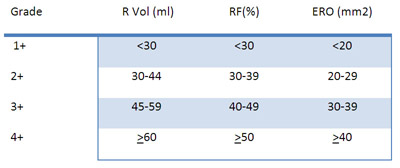
Echocardiography is the key diagnostic examination in patients with degenerative mitral valve disease. It confirms the diagnostic of Barlow's disease by revealing excess leaflet tissue. Mitral valve leaflets are also thickened particularly at their free margin. Another characteristic feature is the billowing of the bellies of the leaflets into the left atrium. The position of the surface of the coapation is also abnormal, near the plane of the mitral orifice. During the evolution of the disease, some patients develop leaflet prolapse (type II dysfunction) involving one or more leaflet segments due to chordae elongation or rupture. Bileaflet prolapse is observed in about 30% of patients. Severe annular dilatation is also a common findings. Finally, echocardiography can show the presence of annular calcification.
In patients with fibroelastic deficiency, there is no excess tissue on echocardiography and leaflets typically have a normal appearance without thickening. Most patients present with the prolapse of one segment mostly p2 due to chordae rupture producing significant valve regurgitation. The prolapsing segment may develop secondary lesions and appear thick on echocardiography. Associated annular dilatation is often mild to moderate. Annular calcification, if present, is usually localized to the posterior segment of the annulus commonly at the base of the prolapsing segment. Occasionaly anterior leaflet prolaspe or bileaflet prolase (type II, P2A2) is diagnosed in patients with fibroelastic deficiency.
The severity of regurgitation can be assessed by semi-quantitative measurements using jet geometry and area in multiple views. The severity of mitral regurgitation is graded on a scale from 1+ to 4+ (1 + trace, 2+ mild, 3+ moderate and 4+ severe mitral regurgitation with flow reversal in the pulmonary veins). On Doppler echocardiography, the direction of the jet is opposite to the prolapsing segment. During the last decade, quantitative Doppler methods have been applied with an increasing frequency to grade the severity of mitral regurgitation. This quantitative grading is based on the calculation of regurgitant volume (the difference between the mitral and aortic stroke volumes) and effective regurgitant orifice (ratio of regurgitant volume to regurgitant time velocity integral). The table below shows the grading severity of mitral regurgitation in quantitative analysis (R Vol= regurgitant volume, RF= regurgitant fraction, ERO= effective regurgitant orifice).

Type I dysfunction
Type II dysfunction
Anterior leaflet prolapse
Fibroelastic Deficiency (FED)
Form Fruste Barlow's Disease
Posterior leaflet prolapse
Bileaflet prolapse
Barlow's Disease
REFERENCES